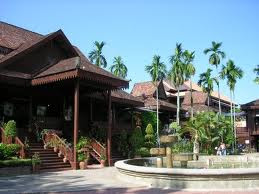~ LAND OF LIGHTNING ~
Kelantan is a state of Malaysia.
The capital and royal seat is Kota Bharu. The Arabic honorific of the state is Darul Naim, ("The Blissful
Abode").
Kelantan is positioned in the north-east of Peninsular Malaysia. It is bordered by Narathiwat Province of Thailand to the north, Terengganu to
the south-east, Perak to the west, and Pahang to the south. To the north-east of
Kelantan is the South China Sea.
Kelantan is located in the north-eastern
corner of the peninsula, Kelantan, which is said to translate as the "Land
of Lightning" (see alternate theories below), is an agrarian state
with lush paddy fields, rustic fishing villages and casuarina-lined
beaches. Kelantan is home to some of the most ancient archaeological
discoveries in Malaysia, including several prehistoric aboriginal settlements.
CULTURES
DIKIR BARAT
Dikir barat is typically performed by groups of ten to fifteen members, though there is no actual set size, even in competitive environments. A group usually sits cross-legged on a platform, sometimes surrounded by the audience. Where the dikir barat is performed competitively, the two competing groups will both be on the stage at the same time.
The is led by the tok juara, who is often the person in charge of the musical training of the group.The creative leader of a dikir barat group is the tukang karut. The tukang karut (who is often himself a former tok juara) is expected in his performance to utilize current social and political issues which will be relevant to the audience. His ability to do this helps to uphold the reputation of the dikir barat group.
WAYANG KULIT
Wayang kulit, or shadow puppets, are without a doubt the best known of the Indonesian wayang. Kulit means skin, and refers to the leather construction of the puppets that are carefully chiselled with very fine tools and supported with carefully shaped buffalo horn handles and control rods. The stories are usually drawn from the Hindu epics the Ramayana, the Mahabharata or from the Serat Menak, (a story about the heroism of Amir Hamza).
" WAU BULAN " (MOON KITE)
Wau bulan is an intricately designed Malaysian moon-kite (normally with floral motifs) that is traditionally flown by men in the Malaysian state of Kelantan. It's one of Malaysia's national symbols, along some others being the kris and hibiscus. The logo of Malaysia Airlines (MAS) is based on this kite.There are many type of wau in Malaysia. Each with its own speciality.Wau kucing(cat kite) and wau merak(peacock kite) are some of them
ATTRACTION PLACES
GUNUNG STONG
Kelantan's highest mountain, rising at a height of 1,433m. It is home to Fish Cave or Gua Ikan, a lone rock that looks like a fish. Take a view at the diversity of flora and fauna, including Rafflesia, the world's largest flower. A highlight is the spectacular Jelawang Waterfalls, acclaimed to be the highest in Southeast Asia.
Handicraft Village and Craft Museum
 |
INFRONT OF CRAT MUSEUM |
AN ACTIVITIES IN A MUSEUM
In Kelantan features an exquisite range of Kelantan handicraft in traditional embroidery, songket weaving, batik printing, silverware, woodcarvings and matting. Some good quality batik and handicrafts are also being sold here. This is one of the most famous tourist attractions in Kota Bharu.
PASAR BESAR SITI KHADIJAH
Unique in every sense, Pasar Besar Siti Khadijah is the most photographed market in the country. This place is a visual delight and a favourite photography subject in Kota Bharu. Located in the heart of Kota Bharu, it used to be known as Pasar Buluh Kubu.
The Market is particularly unique because most traders at the market are women.
This is a 'must visit' destination in this town and the three-storey building houses hundreds of stalls that sell all kinds of fresh produce, traditional local delights, spices, sweets, batik, silver and bronze items as well as many other types of household products.
LOCAL DISHES
NASI KERABU
Another rice-based dish, is served with coconut milk. flaked fish, desiccated coconut and a variety of herbs and sauces.
BUDU
 |
DISHES WITH BUDU |
PACKAGING OF BUDU
It is traditionally made by mixing anchovy and salt
in the range of ratio of 2:1 to 6:1 and allow to ferment for 140 to 200 days.
It is used as a flavoring and is normally taken with fish, rice and raw
vegetables.
KUIH AKOK
One
of the most unique aspect about Kelantanese food is their traditional pudding
known as ‘Kuih Akok’. Made from eggs, flour, coconut milk and palm sugar, Kuih
Akok is baked using a special brass mould resulting in a sponge-like
appearance.
Because
of its popularity, traditional Kuih Akok sellers are commonly seen along the
street side. Tradtionally, Kuih Akok is made using a makeshift oven consisting
of just pieces of bricks and fire from coconut husk. Hence, it is not
surprising to find stacks of coconut husks at these stalls along the roads.
Another way of baking Kuih Akok is using charcoal. During the recent Chinese
New Year trip, I was lucky enough to witness first hand on how these delicious
pudding is made.
It
is commonly believe that charcoal in baking Kuih Akok produces a special aroma
and taste that cannot be replicated using modern equipment.



.jpg)

.jpg)








No comments:
Post a Comment